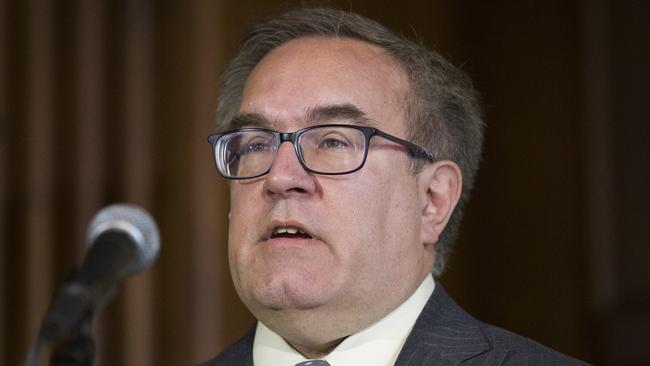Trump coal call defies industry on climate change
A new plan aimed at boosting coal-fired plants, would limit the EPA’s ability to mandate tougher emissions regulations.

The Trump administration moved to try to revive the coal power industry yesterday, overturning Obama administration policies aimed at stemming climate change and adopting rules that could allow older power plants to continue operating.
A new plan, signed by Environmental Protection Agency Administrator Andrew Wheeler, replaces rules that sought to mandate a shift away from coal to cleaner sources of power, including natural gas, wind and solar.
The Obama-era rules had been blocked by legal challenges from 26 states, industry groups and others that cited concerns including the costs of compliance and the EPA’s authority to enact such a sweeping change. Mr Wheeler said the new Affordable Clean Energy rules will restore authority to states, but would require some power plants to adopt newer technology to remain in operation.
“These provisions will give states and the private sector the regulatory certainty they need to invest in new technologies that are more efficient and reduce emissions,” Mr Wheeler said. “We are trying to address climate change. But we are trying to do it within the authority Congress has given us.”
The EPA estimates the plan will help shrink power plants’ carbon dioxide emissions 35 per cent by 2030, compared with 2005 levels, but says almost all the improvement will come from actions the industry takes on its own.
Environmentalists say the new rules don’t go nearly far enough at a time when the risks of climate change are becoming more pronounced. A UN panel last year said that to avoid the worst effects of climate change, global emissions would have to fall at nearly double the rate the Trump administration’s plan estimates will happen in the US power industry.
California Attorney-General Xavier Becerra called the EPA’s new rules “disgraceful and immoral’’. He intends to sue to stop the plan, as does New York, and the two states have been working as part of a coalition of more than a dozen states and some of the country’s largest cities to fight this and other Trump administration environmental policies. He disputes that the EPA has the power to overturn the Obama-era rules.
Even with the Obama-era plan on hold, the power industry kept closing coal-fired power plants, in part due to the declining cost of other power sources. US coal consumption reached a 39-year-low of 687 million tonnes last year, and is set to fall further to 602 million tonnes this year and 567 million tonnes next year, the US Energy Information Administration says.
The power sector, which used 636.5 million tonnes last year, is by far the largest US consumer of coal, the EIA said.
If the regulatory changes survive legal challenges, they could prolong the life of some older coal-fired plants as well as natural gas plants that would otherwise have faced escalating expenses to comply with environmental mandates.
Those plants remain under fierce pressure to compete economically. Newer, combined-cycle natural gas plants produce power more efficiently, and wind power has become a strong competitor to coal in much of the US heartland.
There are no utility-scale coal plants being built in the US. The only coal plant built in the country since 2015 is a small facility at the University of Alaska Fairbanks.
Natural gas creates half of the emissions of coal, and has become the nation’s top source of electricity since a recent drilling boom.
Power companies are adopting zero-carbon generation from wind and solar. Industry leaders say it is what consumers and investors want, and many say the largest power companies are unlikely to embrace coal again.
The Obama plan projected power plant CO2 emissions would fall by 32 per cent from 2005 to 2030. Emissions are already down by 28 per cent from 2005 to 2017, according to federal data.
Utilities in the Edison Electric Institute, the largest industry trade group, are on pace to reduce carbon dioxide emissions 50 per cent by 2030 from 2005 levels. The companies cover more than 70 per cent of US electricity consumers.
The rules work by limiting the EPA in several ways, most prominently by allowing the agency to regulate only “inside the fence-line” of each plant, the EPA says. It will create a menu of technological options each individual plant can choose from to boost efficiency.
The Wall Street Journal



To join the conversation, please log in. Don't have an account? Register
Join the conversation, you are commenting as Logout